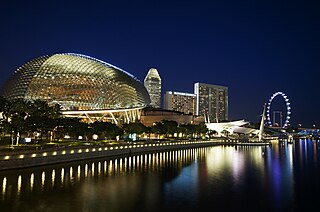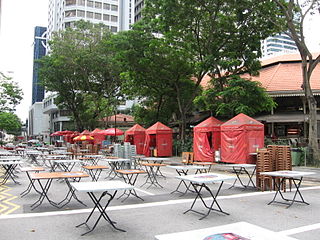Related Research Articles

Satay, or sate in [ dish of seasoned, skewered and grilled meat, served with a sauce. The earliest preparations of satay originated in Java, Indonesia. but has spread to almost anywhere in Indonesia, where it has become a national dish. Indonesian satay is often served with peanut sauce and kecap manis – a sweet soy sauce, and is often accompanied with ketupat or lontong, a type of rice cake, though the diversity of the country has produced a wide variety of satay recipes. It is also popular in many other Southeast Asian countries including Brunei, Malaysia, Philippines, Singapore and Thailand. It also recognized and popular in Suriname and the Netherlands. In Sri Lanka, it has become a staple of the local diet as a result of the influences from the local Malay community.
Singapore has a diverse music culture that ranges from rock and pop to folk and classical. Its various communities have their own distinct musical traditions: the Chinese form the largest ethnic group in Singapore, with Malays, Indians as well as a lesser number of other peoples of different ethnicities including Eurasians. The different people with their traditional forms of music, the various modern musical styles, and the fusion of different forms account for the musical diversity in the country.

Clarke Quay MRT station is an underground Mass Rapid Transit (MRT) station on the North East line (NEL) in Singapore. Situated along Eu Tong Sen Street, near the junction of Merchant Road and North Canal Road, it is at the south of the Singapore River underneath The Central. The station serves Clarke Quay and Boat Quay, as well as other landmarks such as Hong Lim Park, The Riverwalk and the Swissotel Merchant Court.

Bak kut teh is a pork rib dish cooked in broth popularly served in Malaysia and Singapore where there is a predominant Hoklo and Teochew community.

Toronto Harbour or Toronto Bay is a natural bay on the north shore of Lake Ontario, in Toronto, Ontario, Canada. Today, the harbour is used primarily for recreational boating, including personal vessels and pleasure boats providing scenic or party cruises. Ferries travel from docks on the mainland to the Islands, and cargo ships deliver aggregates and raw sugar to industries located in the harbour. Historically, the harbour has been used for military vessels, passenger traffic and cargo traffic. Waterfront uses include residential, recreational, cultural, commercial and industrial sites.

Raffles Place is the centre of the Financial District of Singapore and is located south of the mouth of the Singapore River. It was first planned and developed in the 1820s as Commercial Square to serve as the hub of the commercial zone of Singapore in Raffles Town Plan. It was renamed Raffles Place in 1858 and is now the site of a number of major banks. It is located in the Downtown Core within the Central Area, and features some of the tallest buildings and landmarks of the country.

Esplanade – Theatres on the Bay or nicknamed as The Durian is a performing arts centre located in the Downtown Core of Singapore near the mouth of the Singapore River. Named after the nearby Esplanade Park, it consists of two rounded structures: one housing a concert hall with about 1,600 seats; and the other a theatre with a capacity of about 2,000 for the performing arts.

The Esplanade is a waterfront location just north of the mouth of the Singapore River in downtown Singapore. It is primarily occupied by the Esplanade Park, and was the venue for one of Singapore's largest congregation of satay outlets until their relocation to Clarke Quay as a result of the construction of a major performance arts venue, the Esplanade - Theatres on the Bay, which took its name from this location.

Marina Bay is a bay located in the Central Area of Singapore, surrounded by the perimeter of four other planning areas, the Downtown Core, Marina East, Marina South and Straits View. The area surrounding the bay itself, also called Marina Bay, is a 360 hectare extension to the adjacent Central Business District. It is also the new downtown of Singapore, built on Singapore's reclaimed land.

Changi Village is a modern village situated at the northern tip of Changi which is at the eastern end of Singapore. It is the usual connecting point for travellers heading to Pulau Ubin or Malaysia by ferry. Fishermen in the kelongs located in the Serangoon Harbour offshore also use this jetty as a drop off point to come onto mainland. Changi Village also has many resorts and leisure facilities to cater for a weekend getaway for many Singaporeans. The area is classified by Urban Redevelopment Authorities as under the planning area of Changi and in the subzone of Changi Point. It is also classified under District 17 for property indexing.
The following lists events that happened during 1994 in Singapore.

Clarke Quay is a historical riverside quay in Singapore, located within the Singapore River Planning Area. The quay is situated upstream from the mouth of the Singapore River and Boat Quay.

Boon Tat Street is in the Downtown Core in the Central Area of Singapore. The street extends from Amoy Street at its western end to the junction of Shenton Way and Raffles Quay.

Lau Pa Sat, also known as Telok Ayer Market, is a historic building located within the Downtown Core in the Central Area of Singapore. It was first built in 1824 as a fish market on the waterfront serving the people of early colonial Singapore and rebuilt in 1838. It was then relocated and rebuilt at the present location in 1894. It is currently a food court with stalls selling a variety of local cuisine.

Newton Food Centre (纽顿熟食中心) is a major hawker centre in Newton, Singapore. The food centre was promoted by the Singapore Tourism Board (STB) as a tourist attraction for sampling Singaporean cuisine. It was first opened in 1971 and it closed down in 2005 as the government wanted to revamp the food centre. The food centre then went through a major renovation before reopening on 1 July 2006.

Change Alley is an air-conditioned shopping arcade in the financial district of Raffles Place in Downtown Core planning area of Singapore. Flanked by the skyscrapers Chevron House and Hitachi Tower, it is an alley that links Raffles Place and Collyer Quay. It was renovated to what it is today in 1989, replacing the old Change Alley whose history dates back as far as 1819.

Sungei Road is a road in Singapore situated between Serangoon Road and Jalan Besar and runs along the Rochor Canal. The area around Sungei Road formerly housed affluent Europeans and Asians, and many ornately designed buildings were built there. Since the 1930s, the road has been synonymous with Sungei Road laksa and the Thieves' Market, the largest and oldest flea market in Singapore, where locals can shop for old bric-a-brac or second-hand goods. The market was permanently closed on 10 July 2017 for "future residential development use".
Adam Road Food Centre, also known as the Adam Food Centre, is a popular hawker centre located next to the Bukit Timah Canal in Bukit Timah, Singapore.
References
- ↑ Kaan 2012, p. 62.
- ↑ Van Esterik, Penny (2008). Food Culture in Southeast Asia. ABC-CLIO. pp. 48–. ISBN 9780313344190.
- ↑ Kaan 2012, p. 40.
- ↑ Kaan 2012, p. 32.
- ↑ Cheam, Jessica (December 9, 2007). "Beach Road could be next prime hot spot". AsiaOne . Archived from the original on March 4, 2008.
- ↑ Kip, Lee Lee (1999). Amber Sands: A Boyhood Memoir (2 ed.). Federal Publications. ISBN 9789810124410.
- ↑ Goh, Robbie B.H. (2003). Theorizing the Southeast Asian City As Text: Urban Landscapes, Cultural Documents and Interpretative Experiences. World Scientific. pp. 44–. ISBN 9789812791283.
- ↑ Tay, Suan Chiang (June 18, 2012). "10 F&B options at Gardens by the Bay". AsiaOne . Archived from the original on June 30, 2013. Retrieved May 27, 2013.
- ↑ Pacific Rim Magazine. Vancouver Community College. 1989.
- ↑ Augustin 1988, p. 52.
- ↑ Fodor's (1989). Fodor's 90: Singapore. Fodor's Travel. ISBN 9780679018247.
- ↑ Augustin 1988, p. 53.
- ↑ Hutton, Wendy (2007). Singapore Food. Marshall Cavendish. pp. 4–. ISBN 9789812613219.
- ↑ Eveland, Jennifer (2007). Frommer's Singapore & Malaysia (5 ed.). John Wiley & Sons. pp. 119–. ISBN 9780470100493.
- ↑ Asiapac (2003). Gateway to Malay Culture. Asiapac. p. 147. ISBN 9789812293268.
- ↑ The Rough Guide to Singapore (4 ed.). Rough Guides. 2003. pp. 127–. ISBN 9781843530756.
- ↑ "Open air foodcourt Satay by the Bay to open Jan 15". The Straits Times . January 3, 2013.(subscription required)
- ↑ The Singapore Visitor. Creation & Communications. 1982.
- 1 2 3 Chua, Andrew (August 14, 1986). "Satay Practice". p. 14.
- ↑ "Alhambra King Satay · Boon Tat St, Singapore".
- ↑ "Lau Pa Sat Satay". 3 August 2012.